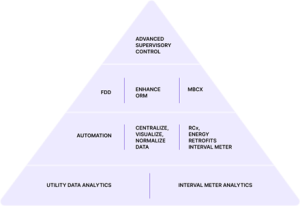By Prabhu Ramachandran, CEO & Co-founder at Facilio
In a world confronted by the undeniable urgency of climate change, decarbonization has become an unmistakable imperative. The need to focus on sustainability is clear from governments to corporations to individuals. While many scopes and methods detail ways to reduce greenhouse gas emissions, the question of where to start remains.
Amidst numerous challenges, reevaluating building management emerges as a practical starting point. While physical retrofits like LED lighting, insulation, and solar panels often come to mind, they can be capital-intensive and time-consuming to yield ROI. Embracing technology offers a faster and more profitable path to sustainable building operations. With the right solution, you can achieve immediate returns and portfolio-wide gains.
Leveraging a hierarchical strategy for carbon management
Technology has emerged as a critical catalyst for change in the pursuit of efficient energy and carbon management. James Dice’s Energy Hierarchy of Needs provides a structured framework that reshapes our approach to this challenge. By aligning our strategies with this hierarchy, we can leverage technology in a way that simplifies energy and carbon management and propels us toward long-term decarbonization progress.

The model categorizes energy and carbon management strategies into distinct layers, each building upon the one below. This model encourages organizations to prioritize their efforts effectively, addressing foundational needs before advancing to more complex solutions. The hierarchy comprises the following layers:
Metering & Measurement: Accurate data collection is the foundation. Manual meter readings or spreadsheets are common starting points.
Automation & Control: Automate routine tasks, using systems like BMS or EMS, to optimize energy usage.
Data Analytics & Optimization: Utilize data and automation for insights. Beware of data complexity when using rudimentary tools like Excel.
Connectivity & Integration: Bridge systems and devices for centralized monitoring, enhancing energy management.
Machine Learning & AI: The pinnacle, using AI to predict, recommend, and adapt in real time.
Traditionally, organizations often adopted point solutions or methods specific to each layer of the hierarchy. For example, they might use Excel spreadsheets for data analytics and manual control for automation. While these solutions address individual needs, they add complexity by creating data silos and disconnected processes. This fragmented approach impedes the holistic progress needed for adequate energy and carbon management.
Shifting to platform-based digital retrofits
A platform-based approach that can serve as a digital retrofit for your buildings is indispensable to overcome these challenges and effectively align with the Energy Hierarchy of Needs. A comprehensive digital platform acts as a trusted partner for owners/operators, regardless of their maturity level in energy management.
This approach offers several advantages:
Seamless Integration: They seamlessly integrate data from various sources and layers of the hierarchy, reducing complexity and providing a holistic view of energy and carbon data.
Scalability: It accommodates organizations’ evolving needs, allowing them to start addressing foundational needs and gradually progress to higher levels of the hierarchy.
Real-time Insights: By leveraging advanced analytics and AI, platforms provide real-time insights that guide decision-making, leading to immediate improvements in energy efficiency.
Future-Proofing: Platform-based tech is designed to meet today’s and future needs, ensuring long-term decarbonization progress.
A platform-based property O&M solution can be a pivotal ally in your decarbonization journey. These platforms seamlessly integrate data, scale with evolving needs, provide real-time insights, and future-proof energy management efforts.
A tiered approach to unlocking energy efficiency
To understand how organizations can systematically improve their energy management practices and sustainability efforts, let us consider each level of the pyramid. It is vital for businesses to understand where they are in their energy management journey and to assess their energy performance and areas for improvement while strategizing on how they can move to the next level.
Step 1: Metering & Measurement – Utility Tracking and Benchmarking
As a first step to implementing an energy management program, organizations will need a mechanism for accurate data collection, which encompasses utility tracking and benchmarking.
Data Requirements at the Metering & Measurement Level:
Utility Bills: Organizations need access to utility bills to begin tracking and benchmarking. These bills provide historical data on their facilities’ energy consumption, costs, and emissions.
Submetering Data: In addition to overall utility bills, submetering data can be essential. Submeters measure energy usage at a more granular level, providing insights into consumption patterns within different areas or systems within a building.
Interval Data: Interval data, typically collected at 15-minute, hourly, or daily intervals, offers a more detailed view of energy usage. This data can help identify peak consumption times and uncover inefficiencies.
Building Characteristics: Information about a building’s physical characteristics, such as square footage, occupancy levels, and operating hours, is necessary for benchmarking against similar buildings.
In the next part of this series, we’ll dive into the other two steps in implementing an efficient energy management program, and take a close look at how to evaluate and align the three most important aspects of a successful decarbonization strategy.
Latest News
Spotlight Interview : Scaler
In our latest Spotlight Interview, we spoke to Helen Cave-Penney, Commercial Director, Scaler. Helen shares how Scaler was created to solve the challenges of fragmented ...
Spotlight Interview : ItBox
In our latest Spotlight Interview, we spoke to Vish Sobti, Business Development Director, ItBox. Vish shares how ItBox was created to tackle the complexities of ...
Thriving in a warming world: how the real estate sector can lead in a carbon neutral economy
By Jeff Blaylock, Director of Client, UK, Deepki Extreme weather is no longer a distant concern—it’s today’s reality. For the second year in a ...